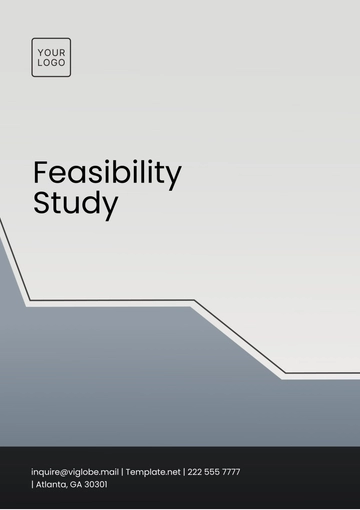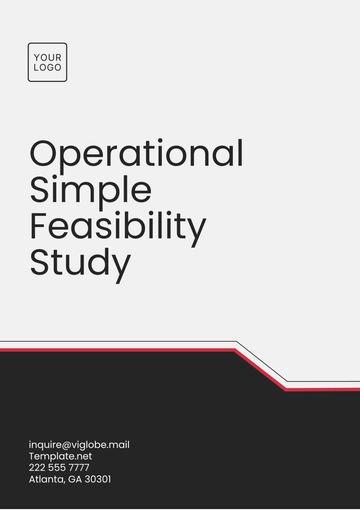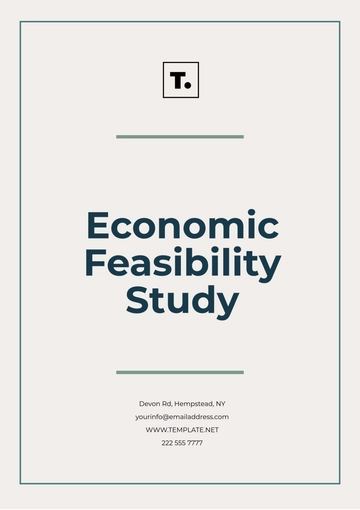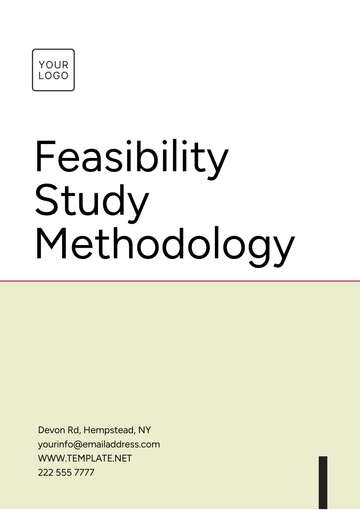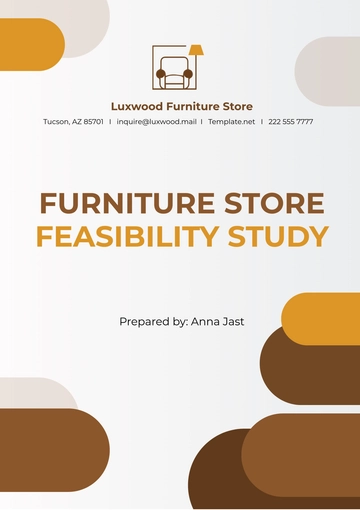Free Startup Business Feasibility Study
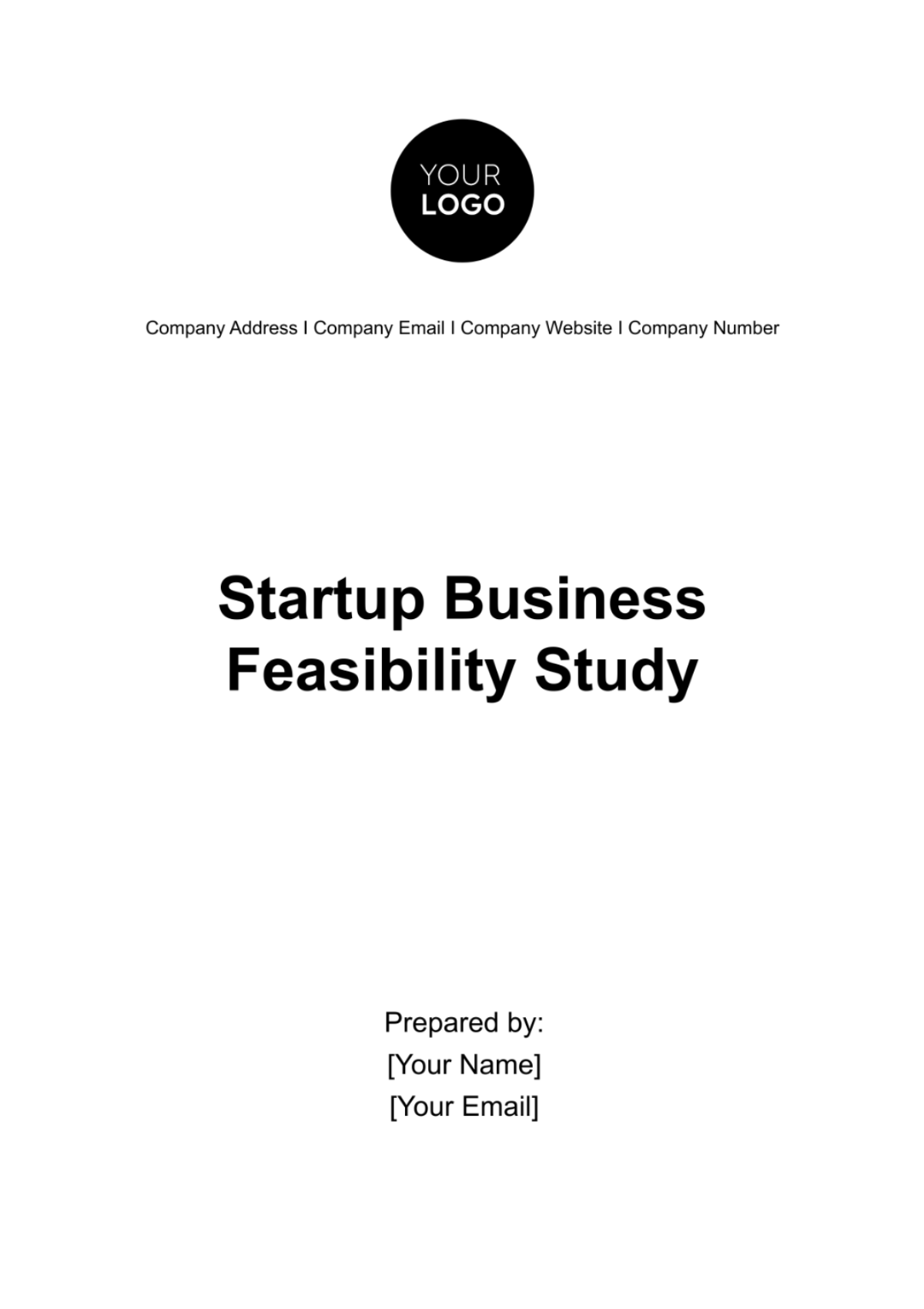
Executive Summary
[Your Company Name] presents this feasibility study to assess the viability of launching a mobile app-based grocery delivery service in urban areas. After thorough analysis of the market, product/service, operations, marketing, and financial aspects, the following key findings have been identified:
There is a growing demand for convenient grocery shopping solutions, especially among urban consumers with busy lifestyles.
Competitive analysis reveals opportunities to differentiate [Your Company Name]'s offerings through superior user experience, extensive product selection, and efficient delivery logistics.
Financial projections indicate a potential for profitability within the first two years of operation, with a projected revenue of [$00 million] by the end of year two. Risks such as potential market saturation, operational inefficiencies, and competition from established players need to be carefully addressed through strategic planning and execution.
Introduction
[Your Company Name] is considering the launch of a mobile app-based grocery delivery service to cater to the needs of urban consumers. This feasibility study aims to provide insights into the feasibility and viability of the proposed venture. The study encompasses a comprehensive analysis of various factors including market dynamics, product/service feasibility, operational requirements, marketing strategies, and financial projections.
A. Objectives:
Assess the market demand and potential for a mobile app-based grocery delivery service.
Evaluate the feasibility of [Your Company Name]'s proposed business model, including revenue streams and cost structure.
Identify potential risks and challenges associated with entering the highly competitive grocery delivery market.
Provide recommendations for mitigating risks and maximizing opportunities to ensure the success of the venture.
B. Scope and Methodology:
The study will focus on urban areas with a population density of over [000] people per square mile.
Data will be collected through a combination of market research, surveys, interviews with industry experts, and analysis of secondary sources.
Analysis will be conducted using both qualitative and quantitative methods, including SWOT analysis, market segmentation, and financial modeling.
The study period covers [start date] to [end date], with projections extending up to [projection period].
Market Analysis
A. Industry Overview
The grocery delivery market is experiencing rapid growth, with a projected CAGR of [00%] between 2050 and 2051, reaching a market size of [$0 billion] by [Year]. This growth is primarily driven by changing consumer lifestyles, increasing urbanization, and the convenience offered by online shopping platforms.
Key players in the industry include [Competitor 1] and [Competitor 2]. While these giants dominate the market, there is still ample room for niche players like [Your Company Name] to carve out a profitable segment by offering specialized services tailored to the needs of urban consumers.
B. Target Market Analysis
The target market for the mobile app-based grocery delivery service consists of urban consumers aged 25-45 with annual incomes of [$00,000] or more. These consumers are typically professionals with busy schedules who value convenience and are willing to pay a premium for time-saving services.
Market research indicates a [00%] increase in demand for online grocery shopping among urban dwellers over the past year, driven by factors such as traffic congestion, limited parking, and the desire to avoid crowded stores, especially in light of the COVID-19 pandemic.
C. Competitor Analysis
Direct competitors such as [Competitor 1] and [Competitor 2] offer similar services but may lack the personalized touch and local market knowledge that [Your Company Name] can provide. By focusing on building strong relationships with local suppliers and offering personalized recommendations based on customer preferences, [Your Company Name] can differentiate itself in the market.
Indirect competitors such as traditional grocery stores with their own delivery services pose a threat due to their established customer base and brand recognition. However, [Your Company Name] can leverage its technological edge and customer-centric approach to attract customers who prioritize convenience and flexibility.
D. Market Trends
Emerging trends such as same-day delivery, eco-friendly packaging, and subscription-based models present opportunities for differentiation and innovation in the grocery delivery market. By aligning with these trends and offering sustainable options, [Your Company Name] can appeal to environmentally conscious consumers and gain a competitive edge.
Consumer preferences are shifting towards organic, locally sourced, and sustainable products, which [Your Company Name] can capitalize on through strategic partnerships with local farmers and suppliers. By offering a curated selection of high-quality, ethically sourced products, [Your Company Name] can attract discerning consumers who are willing to pay a premium for premium products.
Product or Service Analysis
A. Description of Service
[Your Company Name]'s mobile app-based grocery delivery service will offer a wide selection of fresh produce, pantry staples, household essentials, and specialty items sourced from local vendors and national suppliers. Customers will have access to an extensive catalog of products, including organic, gluten-free, and vegan options, catering to diverse dietary preferences and lifestyle choices.
The user-friendly app will feature intuitive navigation, personalized recommendations, and seamless checkout, enhancing the overall shopping experience for customers. In addition, customers can schedule deliveries at their convenience, track orders in real-time, and communicate with delivery personnel for special instructions or preferences.
B. Service Development Plan
The development of the mobile app will be outsourced to a reputable software development firm with expertise in e-commerce and mobile applications. The development process will follow agile methodologies, allowing for iterative improvements based on user feedback and market demand.
Milestones include app design and development, beta testing, and launch preparations, with an estimated timeline of 12 months from project initiation. During the development phase, [Your Company Name] will collaborate closely with the development team to ensure that the app meets the highest standards of usability, functionality, and security.
C. Supplier Partnerships
[Your Company Name] will establish partnerships with local farmers, wholesalers, and distributors to ensure a diverse and high-quality product selection. These partnerships will enable [Your Company Name] to offer fresh, seasonal produce, artisanal products, and specialty items that are not readily available in traditional grocery stores.
Negotiations will focus on securing competitive pricing, reliable delivery schedules, and exclusive product offerings to differentiate [Your Company Name] from competitors. By forging strong relationships with suppliers, [Your Company Name] can ensure a steady supply of inventory and maintain consistency in product quality and availability.
Operational Plan
A. Business Model
[Your Company Name]'s business model for the mobile app-based grocery delivery service is based on a combination of subscription fees, delivery charges, and partnerships with local suppliers. The following table outlines the key revenue streams and cost structure:
Revenue Streams | Description |
|---|---|
Subscription Fees | Monthly or annual subscription fees for premium features and benefits. |
B. Supply Chain Management
[Your Company Name] will establish a robust supply chain to ensure timely delivery of products to customers. The supply chain process involves the following key steps:
Procurement: Sourcing products from local farmers, wholesalers, and distributors.
Inventory Management: Monitoring inventory levels and optimizing stock levels to meet demand.
Warehousing: Storing products in strategically located warehouses for efficient distribution.
Logistics: Managing the transportation of goods from warehouses to customers' doorsteps.
C. Production Plan
As [Your Company Name] operates in the service industry, there is no traditional production process involved. However, operational efficiency is crucial in ensuring timely order fulfillment and customer satisfaction. The production plan includes:
Staff Training: Providing comprehensive training to delivery personnel on product knowledge, customer service, and safe handling practices.
Delivery Optimization: Utilizing route optimization algorithms to minimize delivery times and maximize efficiency.
Quality Control: Implementing quality control measures to ensure accurate order fulfillment and product freshness.
Marketing Plan
A. Marketing Strategy
[Your Company Name]'s marketing strategy aims to build brand awareness, attract new customers, and retain existing ones through targeted marketing campaigns and promotions. The following channels and tactics will be utilized:
Digital Marketing: Leveraging social media platforms, search engine optimization (SEO), and online advertising to reach target audiences.
Influencer Partnerships: Collaborating with influencers and bloggers in the lifestyle and food industry to promote [Your Company Name]'s services.
Referral Program: Implementing a referral program to incentivize existing customers to refer friends and family members.
B. Sales Forecast
[Your Company Name] projects the following sales figures for the first three years of operation:
Year | Total Sales (in $) |
|---|---|
2050 | $500,000 |
2051 | $1,200,000 |
Factors influencing sales include market penetration, customer acquisition rate, and seasonality trends.
C. Promotional Plan
[Your Company Name] will implement various promotional activities to attract and retain customers, including:
Launch Promotions: Offering discounts and incentives to early adopters and first-time customers.
Loyalty Programs: Rewarding loyal customers with exclusive discounts, special offers, and personalized perks.
Seasonal Campaigns: Creating seasonal marketing campaigns around holidays and special occasions to drive sales and engagement.
Financial Plan
A. Startup Costs
[Your Company Name] anticipates the following startup costs associated with launching the mobile app-based grocery delivery service:
Startup Costs | Amount ($) |
|---|---|
Technology Development | $8,000 |
B. Revenue Projections
[Your Company Name] projects the following revenue figures for the first three years of operation based on market analysis and sales forecasts:
Year | Revenue (in $) |
|---|---|
2050 | $800,000 |
2051 | $2,500,000 |
C. Profit and Loss Statement
The projected profit and loss statement for [Your Company Name] for the first year of operation is as follows:
Item | Amount ($) |
|---|---|
Revenue | $10 million |
Cost of Goods Sold | $200,000 |
Gross Profit | $0,000 |
D. Cash Flow Forecast
[Your Company Name] forecasts the following cash flow projections for the first year of operation:
Month | Cash Inflow | Cash Outflow | Net Cash Flow |
|---|---|---|---|
January | $100,000 | $80,000 | $20,000 |
E. Break-Even Analysis
[Your Company Name] anticipates reaching the break-even point within [timeframe] based on the following assumptions:
Average monthly revenue: | $150,000 |
Average monthly fixed costs: | $50,000 |
Contribution margin: | 60% |
Risk Analysis
[Your Company Name] has identified the following potential risks and challenges associated with launching the mobile app-based grocery delivery service:
Market Saturation Risk: The grocery delivery market may become saturated with competitors, leading to increased competition and pressure on prices.
Operational Inefficiencies: Challenges related to logistics, inventory management, and delivery may result in operational inefficiencies and customer dissatisfaction.
Regulatory Compliance Risk: Compliance with local regulations and licensing requirements may pose challenges and lead to additional costs and delays.
Cybersecurity Risk: The mobile app may be vulnerable to cybersecurity threats such as data breaches, hacking, and fraud, which could damage [Your Company Name]'s reputation and result in financial losses.
Economic Downturn Risk: Economic downturns or recessions may impact consumer spending habits and lead to decreased demand for discretionary services such as grocery delivery.
[Your Company Name] will implement risk mitigation strategies such as diversifying revenue streams, investing in technology and infrastructure, maintaining strict compliance with regulations, implementing robust cybersecurity measures, and closely monitoring market trends and economic indicators to proactively address risks and challenges.
Conclusion
After conducting a thorough feasibility study, [Your Company Name] concludes that launching the mobile app-based grocery delivery service is a viable and lucrative opportunity. The analysis of market trends, competitor landscape, operational requirements, and financial projections indicates strong potential for success. Key findings and recommendations are summarized as follows:
Market Opportunity: The growing demand for convenient grocery shopping solutions, coupled with emerging trends favoring online delivery services, presents a significant opportunity for [Your Company Name] to capture market share and establish a competitive position.
Competitive Advantage: [Your Company Name] has identified unique selling points such as personalized customer experience, extensive product selection, and strategic partnerships with local suppliers, which differentiate it from existing competitors.
Financial Viability: Financial projections indicate a positive outlook, with projected revenues exceeding startup costs and achieving profitability within the first year of operation. The break-even analysis demonstrates a favorable timeline for reaching profitability.
Risk Mitigation: While certain risks and challenges exist, [Your Company Name] has developed comprehensive risk mitigation strategies to address potential threats such as market saturation, operational inefficiencies, regulatory compliance, cybersecurity, and economic downturns.
Based on these findings, [Your Company Name] is confident in the feasibility and success of the proposed venture. The next steps involve proceeding with the implementation of the business plan, including finalizing partnerships, developing the mobile app, hiring staff, and launching marketing campaigns.
- 100% Customizable, free editor
- Access 1 Million+ Templates, photo’s & graphics
- Download or share as a template
- Click and replace photos, graphics, text, backgrounds
- Resize, crop, AI write & more
- Access advanced editor
Explore the Startup Business Feasibility Study Template on Template.net, your trusted resource hub for startup essentials. This editable and customizable template facilitates a thorough analysis of your business idea's viability. With our Ai Editor Tool, tailor the study to your specific needs, helping you make informed decisions about your startup's future. Kickstart your entrepreneurial journey with this essential template, available for download now.



